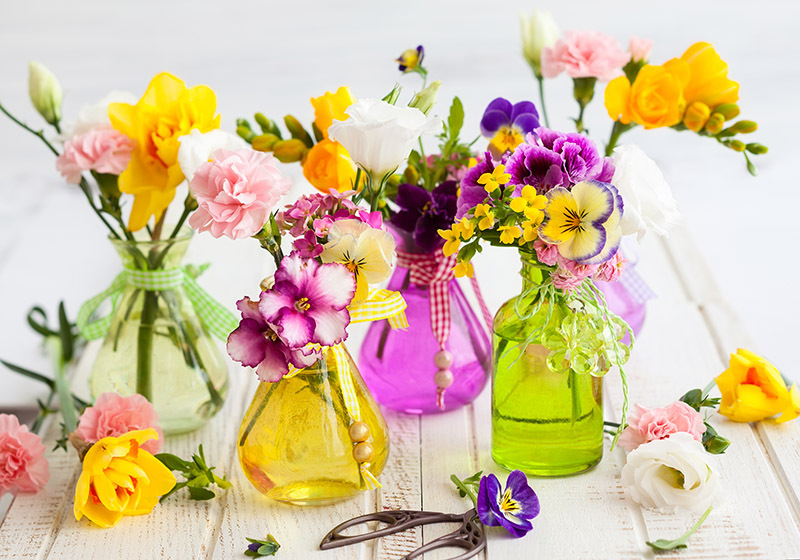Beyond the Bloom: Discover 8 Amazing Sunflower Facts
Posted on 03/07/2025
Beyond the Bloom: Discover 8 Amazing Sunflower Facts
The sunflower, with its radiant petals and striking height, has intrigued gardeners and nature lovers for centuries. Beyond their tawny beauty, sunflowers are packed with fascinating secrets and a dynamic history. In this comprehensive guide, we move past their golden blooms to reveal eight remarkable sunflower facts you might not know. Join us on an illuminating journey as we explore the wonders behind this charismatic plant!

1. Sunflowers Are Native to North America
Contrary to popular belief, sunflowers did not originate in Europe. These cheerful giants are native to North America, most likely first domesticated around 1000 BC by Native American peoples. Sunflowers were grown not just as a food crop but for medicinal, textile, and ceremonial purposes as well. It was not until the 16th century that Spanish explorers introduced sunflower seeds to Europe, where sunflowers quickly blossomed in popularity.
- Sunflowers have been cultivated for over 4,000 years.
- Native American tribes utilized every part of the sunflower--from the edible seeds to the stalk and leaves.
- Modern variants now grow across the globe, but their origins remain tied to North America.
Why Are Sunflowers So Significant in Native American Culture?
For many indigenous groups, sunflowers symbolized harvest and bounty. Seeds provided crucial nutrients, while sunflower oil became a valuable commodity. Sunflower heads even functioned as calendar markers for seasonal events due to their consistent growth patterns.
2. Sunflowers Exhibit Heliotropism - They "Chase" the Sun
One of the most captivating amazing sunflower facts is that young sunflowers display heliotropism--the unique ability to turn their faces toward the sun across the sky. Each morning, sunflower buds start their day facing east, and as the sun moves, they gently track it westward. By nightfall, they reset to the east again, ready for sunrise.
- Heliotropism helps optimize growth by increasing the exposure to sunlight--vital in their early stages.
- Once sunflowers mature and their stems stiffen, they tend to stay facing east permanently.
- This phenomenon isn't just for show; it kickstarts the process of photosynthesis and helps the plant thrive.
How Does Heliotropism Work?
The sunflower's unique ability to follow the sun is powered by growth hormones called auxins. These accumulate on the shaded side of the stem, causing those cells to elongate and the flower head to tilt toward the light. This remarkable adaptation ensures maximum sunlight absorption during the crucial growth phase.
3. Sunflowers Are Giants of the Plant World
When it comes to impressive height, sunflowers are among the tallest flowers on earth. Some varieties, like the mammoth sunflower, regularly soar over 10 feet high, with the world record set at a staggering 30 feet, 1 inch (9.17 meters)!
- The largest recorded sunflower was grown by Hans-Peter Schiffer in Germany in 2014.
- Sunflower stems can be incredibly thick and woody, providing natural structural support.
- Sunflowers' rapid growth rate makes them a favorite in children's garden projects.
How to Grow Record-Breaking Sunflowers
If you're seeking to cultivate your own giant sunflowers, remember these tips:
- Plant in well-drained, nutrient-rich soil
- Ensure full sun exposure--at least 6 to 8 hours daily
- Keep soil consistently moist, but not waterlogged
- Support tall plants with stakes to prevent breakage
4. Each Sunflower Head Is an Array of Mini Flowers
When you gaze upon a sunflower's bold head, you might assume it's a single giant flower. In reality, each sunflower head (capitulum) is composed of thousands of tiny "florets". These are packed together in a mesmerizing spiral pattern, each one capable of producing a seed.
- Two types of florets exist: ray florets (the "petals") and disk florets (the central section).
- The disk florets mature into seeds, while the ray florets attract pollinators like bees and butterflies.
- This intricate spiral is not random--it follows the mathematical Golden Ratio!
Why Is This Structure So Efficient?
By arranging their seeds according to the Fibonacci sequence, sunflowers maximize the number of seeds per head, efficiently packing as many as possible into the available space. This natural ingenuity makes sunflowers both beautiful and productive.
5. Sunflower Seeds: Nutrition Powerhouses and Versatile Snacks
Among sunflower facts you should know is their incredible value as a nutritious food source. Sunflower seeds are popular snacks worldwide, brimming with protein, healthy fats, vitamins, and minerals.
- Sunflower seeds are high in vitamin E, magnesium, and selenium.
- Seeds are pressed to make sunflower oil, widely used for cooking and in cosmetics.
- Sunflower butter--an alternative to peanut butter--is a rising star for those with nut allergies.
Health Benefits of Sunflower Seeds
A regular serving of sunflower seeds may help improve heart health, support the immune system, and foster healthy skin. Their antioxidant-rich profile makes them a smart choice for snacking or adding crunch to salads and baked goods.
6. Sunflowers Cleanse and Remediate the Environment
Beyond their decorative and dietary contributions, sunflowers also serve as natural environmental heroes. Sunflowers can absorb toxic substances--including heavy metals like lead, arsenic, and uranium--from contaminated soil through a process called phytoremediation.
- After the Chernobyl nuclear disaster, sunflowers were used to help decontaminate radioactive soil and water.
- Their extensive root system is ideal for pulling toxins from deep within the earth.
- This unique property opens a promising avenue for eco-friendly soil remediation projects worldwide.
Phytoremediation in Action
By planting sunflowers in polluted fields or gardens, scientists and farmers naturally reduce soil toxicity over time. This sustainable strategy not only protects human and animal health but also revitalizes landscapes for future cultivation.
7. Sunflowers Symbolize Positivity and Joy Across Cultures
Few flowers evoke happiness quite like the sunflower. Their sunny appearance has led to rich symbolism in art, literature, and tradition globally. In many cultures, sunflowers represent loyalty, longevity, and adoration--always seeking the light, just as we seek hope and warmth.
- Vincent van Gogh's "Sunflowers" paintings immortalized them as artistic icons.
- In Chinese culture, they symbolize good luck and lasting happiness.
- Sunflowers are often used in weddings to represent unwavering faith and cheerfulness.
A Symbol for All Seasons
Whether used in bouquets, gardens, or as stunning home decor, sunflowers lift spirits and inspire optimism. They're a perennial favorite for floral enthusiasts and artists alike.
8. Sunflowers Support Global Agriculture and Wildlife
Sunflowers are more than beautiful--they are a vital pillar in global agriculture and biodiversity. Vast fields of sunflowers offer valuable resources for farmers and wildlife year-round.
- Sunflowers act as pollinator magnets, attracting bees, butterflies, and beneficial insects.
- Their seeds provide food for birds, small mammals, and even livestock.
- Sunflower by-products, such as meal and hulls, are utilized in animal feed and green fertilizers.
Sunflowers and Sustainable Farming
Because sunflowers thrive in diverse climates and soils, they're an important crop globally. They help manage crop rotation systems, promoting healthy fields and sustainable practices. Sunflowers' deep roots also improve soil quality and help prevent erosion.
Frequently Asked Questions About Sunflowers
What is the best month to plant sunflowers?
Sunflowers should be planted in late spring when soil temperatures reach at least 55-60?F (13-16?C). In most regions, this is between April and June.
How long does it take a sunflower to bloom?
Depending on the variety, sunflowers typically bloom within 70 to 100 days after planting. It's a relatively short wait for such a vibrant display!
Can you eat all sunflower seeds?
While most sunflower varieties produce edible seeds, some grown purely for ornamental purposes may not have palatable or easily harvestable seeds. Stick to varieties labeled for seed production if you intend to snack on your harvest.
Are sunflowers easy to grow?
Absolutely! Sunflowers are renowned for being beginner-friendly. Provide lots of sun, water, and well-draining soil, and you'll have a cheerful crop in no time.

Conclusion: Celebrate the Unsung Wonders of Sunflowers
From their ancient roots to their starring role as pollinator havens, soil cleansers, and global food sources, sunflowers go far beyond their golden blooms. As we've explored these eight amazing facts about sunflowers, it's clear that their significance is as rich and dynamic as their appearance.
Whether you're growing a sunflower in your backyard, munching on their nutritious seeds, or simply admiring a field of nodding heads, remember there's so much more to sunflowers than meets the eye. Celebrate these sunny giants--not just in summer, but all year round.
Ready to Grow Your Own Sunflower Marvels?
Discover the many reasons to plant sunflowers in your garden--beauty, nourishment, sustainability, and joy. Start with just a handful of seeds and watch as your garden transforms, bursting forth with vibrant energy and endless fascinating stories.
Go beyond the bloom, and uncover the wonders of the sunflower every day!
Latest Posts
Find Out What Traits Your Birth Flower Associates With You
Keeping Your Poinsettias Healthy and Bright
Identify the Flower That Mirrors Your Inner Beauty






